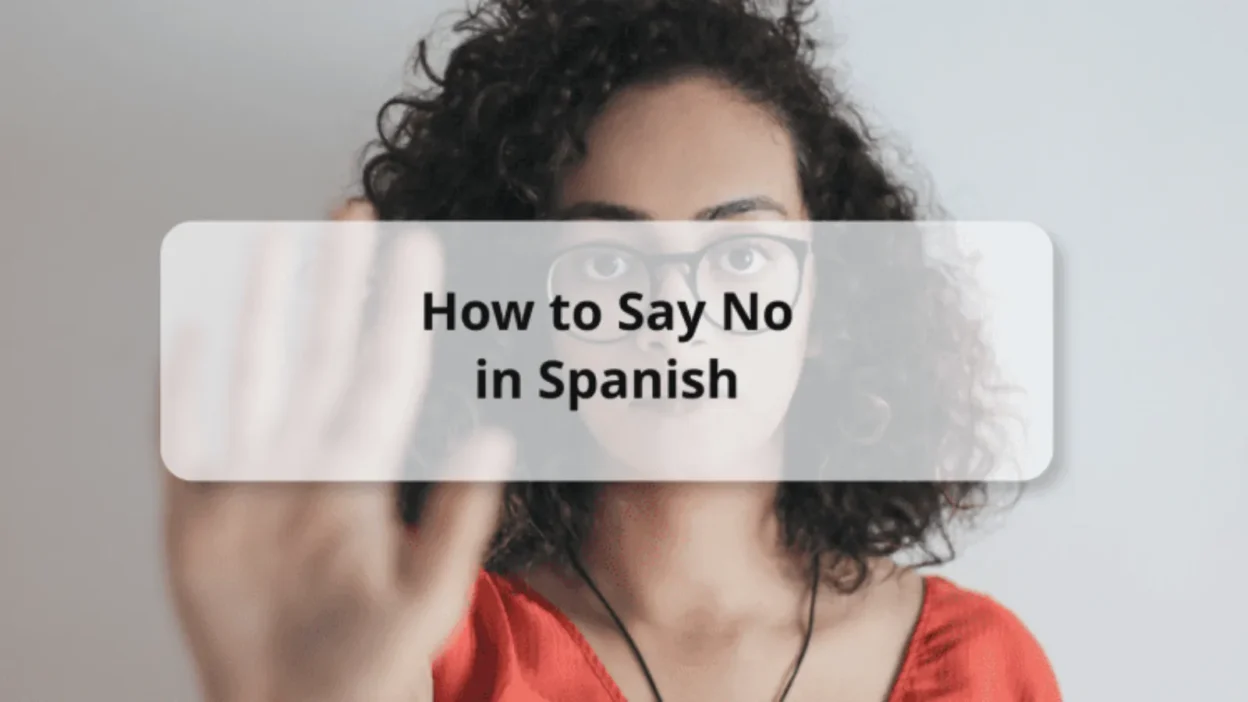How to Say No in Spanish is an essential skill for any learner who wants to speak clearly, confidently, and respectfully. If you’re turning down an invitation, refusing politely in a conversation, or just setting a boundary, knowing the right Spanish phrases helps you communicate with ease. Spanish offers many ways to say no from direct to more polite or culturally appropriate expressions.
In this guide, you’ll learn how to say no in Spanish naturally, along with examples to help you use each phrase in the right context.
Mastering how to say no in Spanish also shows cultural awareness and improves your confidence in real-life situations. With just a few simple phrases, you can avoid awkward moments and speak more like a native.
Say No in Spanish:
Let’s explore 15 practical and expressive ways to say no in Spanish—with real-life dialogue examples and cultural context to help you sound authentic.
15 Ways to Say No in Spanish (Short Table)
| Phrase | Spanish | Pronunciation | Use |
|---|---|---|---|
| 1. No | No | no | Basic refusal |
| 2. No, thank you | No, gracias | no GRAH-syahs | Polite |
| 3. I don’t want | No quiero | no kyeh-ro | Refusal |
| 4. I can’t | No puedo | no PWEH-do | Unable |
| 5. Absolutely not | ¡Claro que no! | KLAH-ro keh no | Strong |
| 6. Not at all | Para nada | PAH-rah NAH-dah | Polite |
| 7. I’d prefer not | Preferiría que no | preh-feh-REE-ree-ah keh no | Polite |
| 8. Sorry, no | Lo siento, no | lo SYEN-to no | Apologetic |
| 9. Never | Nunca | NOON-kah | Strong |
| 10. No way | De ninguna manera | deh neen-GOO-nah mah-NEH-rah | Casual/strong |
| 11. No problem | No hay problema | no ay pro-BLEH-ma | Informal |
| 12. Not possible | No es posible | no es po-SEE-bleh | Denying |
| 13. Don’t | No hagas | no AH-gahs | Command |
| 14. No, of course not | No, por supuesto | no por soo-PWEH-sto | Polite denial |
| 15. No means no | No es no | no es no | Strong/clear |
1. No
Origin:
The most basic and universal way to say no in Spanish, identical to English in both spelling and meaning.
Example:
👤 Usuario A: ¿Quieres salir esta noche?
👤 Usuario B: No, estoy cansado.
Use: Direct, simple, and most common.
2. Para nada (Not at all)

Origin:
Literally means “for nothing,” used to strongly deny or reject something.
Example:
👤 Usuario A: ¿Te molesta si pongo música?
👤 Usuario B: Para nada, adelante.
Use: Emphatic but polite denial; often softens the tone.
3. Ni hablar (No way / Not a chance)
Origin:
Translates to “not even to talk about it.” A common expression in Spain and Latin America.
Example:
👤 Usuario A: ¿Vas a aceptar ese trabajo tan lejos?
👤 Usuario B: ¡Ni hablar! Es una locura.
Use: Strong refusal; casual but emphatic.
4. De ninguna manera (By no means)
Origin:
A formal phrase used to clearly and firmly deny something.
Example:
👤 Usuario A: ¿Puedes mentir por mí?
👤 Usuario B: De ninguna manera. No puedo hacer eso.
Use: Firm, polite, and respectful.
5. No puedo (I can’t)
Origin:
Adds a sense of limitation rather than outright rejection, softening the “no.”
Example:
👤 Usuario A: ¿Puedes ayudarme mañana?
👤 Usuario B: Lo siento, no puedo. Tengo una cita.
Use: Polite and empathetic refusal.
6. Lo siento, pero no (I’m sorry, but no)
Origin:
Combines apology with refusal, showing consideration.
Example:
👤 Usuario A: ¿Vienes a mi fiesta?
👤 Usuario B: Lo siento, pero no puedo. Trabajo esa noche.
Use: Respectful and kind.
7. Claro que no (Of course not)

Origin:
Used to clearly dismiss a false assumption or emphasize refusal.
Example:
👤 Usuario A: ¿Tú dijiste eso de mí?
👤 Usuario B: ¡Claro que no! Jamás lo haría.
Use: Emphatic and reassuring.
8. En absoluto (Absolutely not)
Origin:
Similar to “para nada,” but more formal and often used in Spain.
Example:
👤 Usuario A: ¿Estás enojado conmigo?
👤 Usuario B: En absoluto. Todo está bien.
Use: Polite denial, often used in professional or formal settings.
9. Ni loco / Ni loca (Not even ridiculous)
Origin:
Common in Latin America, especially Argentina; humorous way to strongly say no.
Example:
👤 Usuario A: ¿Te lanzarías del paracaídas?
👤 Usuario B: ¡Ni loco!
Use: Informal and expressive.
10. No, gracias (No, thank you)
Origin:
Universal polite form used to decline offers or invitations.
Example:
👤 Usuario A: ¿Quieres más pastel?
👤 Usuario B: No, gracias. Ya estoy lleno.
Use: Always appropriate, especially in social situations.
11. No es posible (It’s not possible)

Origin:
Impersonal phrasing to avoid direct refusal; common in customer service or formal responses.
Example:
👤 Usuario A: ¿Podría cambiar mi reserva para hoy?
👤 Usuario B: Lo siento, no es posible. No hay disponibilidad.
Use: Formal and polite.
12. No quiero (I don’t want to)
Origin:
Direct expression of will, which can sometimes sound blunt—use carefully.
Example:
👤 Usuario A: ¿Quieres venir conmigo al museo?
👤 Usuario B: No quiero, prefiero descansar.
Use: Honest, but may need softening in polite company.
13. Ya no (Not anymore)
Origin:
Used to indicate that something was true before, but no longer is.
Example:
👤 Usuario A: ¿Sigues estudiando medicina?
👤 Usuario B: Ya no, cambié de carrera.
Use: Contextual refusal related to time or change.
14. No me interesa (I’m not interested)
Origin:
Common in commercial or social contexts to decline offers or topics.
Example:
👤 Usuario A: ¿Te gustaría unirte a nuestro club?
👤 Usuario B: Gracias, pero no me interesa.
Use: Honest and to-the-point.
15. No tengo ganas (I don’t feel like it)
Origin:
Used to express lack of motivation; casual and emotional in tone.
Example:
👤 Usuario A: ¿Vamos al cine hoy?
👤 Usuario B: No tengo ganas. ¿Mañana?
Use: Informal and honest; often used among close friends.
FAQs
- What is the basic way to say “no” in Spanish?
The simple word is “No.” It’s pronounced just like English. - Is “No” used the same way in Spanish as in English?
Yes, you can use No in almost every situation to refuse, disagree, or answer negatively. - How do you say “No, thank you” in Spanish?
You can say “No, gracias.” - How do you politely refuse someone in Spanish?
Say “No, lo siento” (No, I’m sorry) or “Preferiría que no” (I’d prefer not to). - How do you say “No problem” in Spanish?
You can say “No hay problema.” - How do you say “Absolutely not” in Spanish?
You can say “¡Claro que no!” - How do you say “I don’t want to” in Spanish?
Say “No quiero.” - How do you say “I can’t” in Spanish?
You can say “No puedo.” - How do you say “No worries” in Spanish?
Use “No te preocupes” (informal) or “No se preocupe” (formal). - How do you say “No means no” in Spanish?
Say “No es no.”
This is a strong, clear statement.
Conclusion:
Now that you’ve explored 15 polite and natural ways for how to say no in Spanish, you’re better equipped to handle real conversations with clarity and confidence. If you’re speaking with friends, coworkers, or strangers, using the right phrase helps you set boundaries respectfully.
Keep practicing these expressions to make your Spanish sound more natural and culturally appropriate.
Learning how to say no in Spanish isn’t just about vocabulary — it’s about communicating with kindness and confidence.



